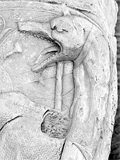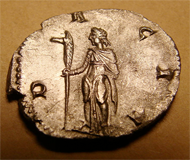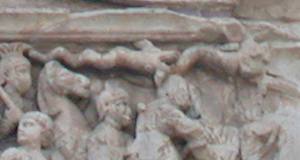
This page created 25 September 2014, and last modified: 23 September 2015 (Maier reference numbers added)

The 22nd of the 32 units of legiones comitatenses listed (98/9.119 in Ingo Maier's numbering scheme) in the Magister Peditum's infantry roster is called the Cortoriacenses; it is assigned (102/5.140) to the Magister Equitum's Gallic command. Its shield pattern (96#12), as shown in various manuscripts under the label (96.m) Prima Flavia Pacis, is as below:

The pattern has a white boss, a red main field edged with a green band (faded to yellow in M, and white in W), and a yellow rim. The field is decorated with a white draco, facing right (left in B, which being printed, reverses all the shield pattern orientations); the break between the head and the end of the tail is in approximately the 12 o'clock position. In P, the head of the draco is red rather than white. The draco was a military standard that was introduced to the Roman forces during the 2nd century AD as a result of the Dacian wars, and which became more popular with time, to judge from e.g. Vegetius, in which (section 2.13) a cohort is given its own standard, kept by a draconarius. Despite the name "draco" (serpent, dragon), the draco often seems to feature a head that looks more wolf-like than serpent-like.

|

|

|
|
|
|
|
|
|
|
|
The pattern of the Cortoriacenses looks rather similar to that of the Menapii seniores (98/9.98), another of the legiones comitatenses in the Gallic field army: these two units appear to be the only infantry units in the Notitia featuring plain single dracones on their shields; the other units are all cavalry (e.g. the Equites Honoriani Taifali iuniores, 102/5.18), or feature draco-looking emblems incorporated onto twin-headed zoomorphic motifs (e.g. the Exculcatores iuniores Britanniciani, 98/9.82).
The name Cortoriacenses refers to Cortoriacum, i.e. modern Kortrijk / Courtrai in Belgium. The Cortoriacenses is one of a number of units that, given their names, appear to have been stationed under the command of the Dux Belgicae secundae in the past but had been transferred into the Gallic field army by the time the Notitia was compiled (or to be more exact, last edited). Other such legionary units are the Geminiacenses (98/9.120), from Geminiacum (modern Liberchies) and listed immediately after the Cortoriacenses in the infantry roster, and the Prima Flavia Metis (98/9.143) from Metis (modern Metz).
Since these three units are not duplicated as being under the command of the Dux Belgicae secundae, in contrast to the many duplicated units under various other western Duces, it seems that the province of Belgicae secundae had many of its units drafted into the depleted Gallic field army before those of many other provinces, if we work on the premise that such deletions from the border forces took time to be deleted from their original listing place in the Notitia Dignitatum, assuming they were listed there in the first place. To these three units we might also add the Tongrecani seniores (98/9.82, after the Civitas Tungrorum, modern Tongeren / Tongres), and the Menapii seniores (98/9.98) itself (after the Civitas Menapiorum, modern Kassel / Cassel), although their very senior positioning in the Magister Peditum's infantry roster implies they had joined a field army long before the Notitia was drawn up: external evidence points to the years 310 to 312 in the case of the Tongrecani.

Return to the Notitia alphabetical unit list page.
Return to my Notitia index page.